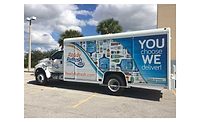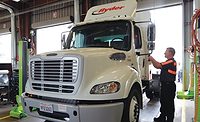Fleets show interest in all-natural fuel solutions

Since nearly the dawn of the automotive age, many “alternative” fuels have been tried, but virtually all have come up lacking when compared with petroleum-based diesel and gasoline. Apart from availability, portability and stability, one of petroleum’s key advantages is what engineers refer to as power density, which, in short, is a measure of how much work a given volume of a fuel will produce.
Other fuels and power sources have positive attributes but have a tough time producing as much work as the same volume or weight of petroleum fuels, and those that are volumetrically competitive generally suffer from production scaling issues.
Two alternatives that are increasingly giving diesel and gasoline a proverbial run for their money are natural gas and propane. Both of these fuels are at a power density disadvantage compared with diesel and gasoline, but not unworkably so, and the significant price advantage for these alternatives offsets most of the power density loss.
Although propane is best suited as an alternative for lighter-duty, gasoline-powered trucks, natural gas is a practical alternative for vehicles ranging from passenger cars up to Class 8 trucks. Recent expansion of natural gas exploration and production in North America has helped keep retail prices for the fuel low and, just as importantly, stable compared with most other energy sources.
At the same time, as natural gas has become more plentiful and less expensive, vehicle manufacturers have developed a much stronger interest in the fuel, mostly because it provides a realistic path to meeting ever-tightening exhaust emission regulations. During the last two years, that increased interest has resulted in the debut of several factory-installed and warranted natural gas powertrains.
Even though the natural gas pipeline network covers most populated areas in the continental United States, the lack of available fueling stations has remained a stumbling block in the way of more widespread use of natural gas as a vehicular fuel. However, as a result of the increased interest in natural gas on the part of both truck manufacturers and fleets, that fueling infrastructure obstacle is rapidly whittling away.
While some fleets with smaller numbers of natural gas vehicles are addressing their infrastructure needs by co-locating publicly accessible fueling locations on or near their warehouse properties, fleets with as few as 100 natural gas vehicles can cost effectively deploy private fueling facilities.
Although it’s practical for a local delivery fleet to fuel up at the same location every time, regional and long-haul operations must rely on publicly accessible fueling stations throughout their operating area. In addition to a growing number of co-located fueling stations, many natural gas distributors/wholesalers are developing free-standing retail fueling locations on their own.
The availability of publicly accessible fueling locations has improved dramatically throughout the last few years. In mid-2012, Freightliner conducted a coast-to-coast natural gas demonstration drive, traveling from Long Beach, Calif., to Washington, D.C., fueling only at publicly accessible natural gas stations.
Many of the top operators in the beverage industry have made or are making serious commitments to deploying natural gas trucks and the necessary fueling infrastructure. To support his natural gas-powered fleet, Ed Pritchard, senior vice president of fleet management and purchasing at Silver Eagle Distributors, worked with Clean Energy Fuels to get a public fueling station located next to his Houston headquarters. Similarly, Bill Osteen, senior vice president of business operations at Tucson-based Golden Eagle Distributors, recently opened the first in a planned series of co-located retail natural gas stations spread across Arizona.
Early in 2013, as part of an ongoing effort to incorporate economically and environmentally sustainable operations into company practices, Fred Dufour, senior vice president of operations at Indianapolis-based Monarch Beverage Co., announced a major deployment of natural gas-powered trucks, along with plans for an on-site fueling infrastructure.
The compressed natural gas (CNG) project will cost approximately $7.6 million — a cost that Dufour is calling an investment. “The initial financial investment involved in the CNG conversion is significant, but the long-term financial and environment benefits merit the switch,” Dufour said. “The conversion will reduce our diesel consumption by close to 1 million gallons annually, reducing fuel prices approximately 60 percent.”
Partners in Monarch Beverage’s CNG project include Cummins Westport, Kenworth Truck Co., Citizens Energy and ProLiance Energy. The innovative partnership began October 2011 with “beta testing” on a 12.0-liter/400 horsepower Cummins Westport engine. The official conversion of the Monarch Beverage fleet from diesel to CNG began in September 2012. Once complete, nearly 100 Monarch Beverage trucks will run on CNG. The CNG station is scheduled to be complete by March.
Monarch already operates 27 Kenworth T440 natural gas trucks. The new trucks will be Kenworth T800s equipped with the new Cummins Westport ISX12 G natural gas engine. BI
Looking for a reprint of this article?
From high-res PDFs to custom plaques, order your copy today!





